David J. Howe's Blog, page 19
November 7, 2016
The DOCTOR WHO Merchandise Museum
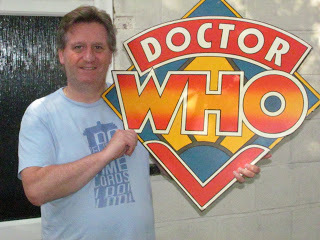
I've loved Doctor Who and its associated merchandise for many, many years. In the 80s my dream was to get a guide published to all the amazing things which had been released ... that failed, and so in the 90s I did it myself along with a brilliant pal and designer called Arnold T Blumberg ... And for as long as I can remember I've loved displaying my collection, in my bedroom, or in the spare room, and latterly in the 'collection room' at home! But as the collection grew and grew I needed more and more space ...
So two years ago, we moved house, mainly to try and acheive the space we needed, and now own a lovely home, and also a business unit in which I can finally host the Doctor Who collection ... so that it's all available to see and appreciate, and we can also allow others to come and see it too and not have people stomping through our house to do so!
But there's an issue ... as explained in more detail in the fundraiser, in part because of a heart attack I suffered in 2016, we don't now have the money to complete the works, and so are running a fundraiser to try and get this, to make this museum a reality!!
There are some smashing perks for those who donate, and more perks are due to come online soon ... So please have a look and see what we're trying to do :)

Standing in the Unit with all the boxed up merchandise waiting
for the Unit works to be completed.
Any and all help is appreciated ... so please share the fundraiser, tell your friends, try and get word out to as many people as you can ... It's all really appreciated.
The fundraiser page is here:
https://www.indiegogo.com/projects/th...
And there's some lovely pieces about it all here:
http://www.markwho42.net/2016/11/06/l...
http://www.doctorwhonews.net/2016/11/...
http://thedoctorwhocompanion.com/2016...
http://www.starburstmagazine.com/tv-n...
https://scifibulletin.com/2016/11/02/...
http://merchandise.thedoctorwhosite.c...
http://news.drwho-online.co.uk/Help-F...
Published on November 07, 2016 05:36
November 2, 2016
Review: The Andrew Skilleter Target Art Calendar 2017
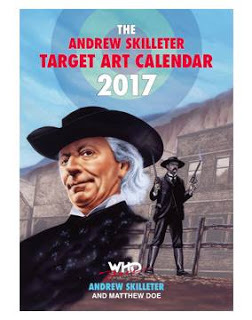
Ah that Target Doctor Who art ... so evocative, and so impressionable on young minds! Those of a certain age will also remember Who Dares, a publishing company set up by artist Andrew Skilleter to sell and promote his own Doctor Who artwork ... It sort of died away some years ago, but now it's back! And their first release is a 2017 Calendar, featuring 12 of Andrew Skilleter's Target paintings.
Calendars are strange beasts. For them to work, you really have to try and increase the production values. Unless of course you're deliberately going for a cheap and cheerful version. For years now we have had annual offerings from Danilo, which have been the same basic shape calendar that they do for all manner of properties, and the imagery hasn't been that inspiring, so it's a pleasure to see that this new offering from Who Dares is all printed on a lovely heavy paper stock. It's nominally A3 sized, though is in actuality slightly larger, and is spiral bound on the top. Each sheet is printed on just one side (with a calendar bound in this way, you could halve the number of pages and print on both sides of the paper with no loss of quality) and so you have 15 sheets (cover, back cover and 12 internal pages) bound together.

The art is all taken from Skilleter's Target covers, and it's a nice selection of some of the best examples of the work that he did for the range. We have 'Warriors of the Deep', 'The Invasion', 'The Twin Dilemma' unused version, 'The Mind of Evil', 'Frontios', 'Nightmare of Eden', 'The Gunfighters', 'The Two Doctors', 'Logopolis', 'The Daemons', 'An Unearthly Child', ' and The Abominable Snowmen'. The print quality is good, and the paintings are shown to their best effect.
The back of the calendar has a set of capsule notes from the artist on each piece, which is nice to see.
Overall this is a heavyweight piece of merchandise, and a step up in quality from what we have been used to in Calendars over recent years. Of course this means it is more expensive at £19.99, that and the fact that it's not been produced in mass market quantities ...
If you're looking for some Doctor Who nostalgia for your wall in 2017, then this calendar is a good bet.

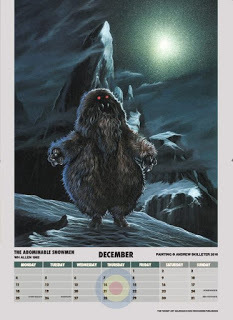
Published on November 02, 2016 08:43
October 26, 2016
Review: DOCTOR WHO: THE WHONIVERSE
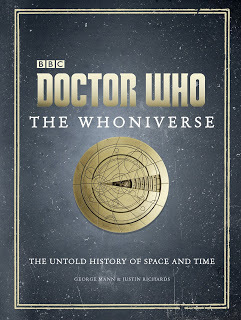
This is quite a tricky book to review if I'm being honest. As a lifelong Doctor Who fan and collector I sometimes feel that there is an expectation to like and enjoy everything ... but real life isn't like that, and as the years and products pass, so sometimes things come out which really aren't as good as perhaps they should be ... and as more and more is produced, one starts to hear the sound of the bottom of a barrel being scraped.
With Doctor Who books, they fall these days into all manner of categories. The programme makers and the merchandisers/publishers have a dicotomy ... they want to sell books to young kids - say the 5 to 10 age group, but the show isn't really aimed at that age group and so sometimes features material which is 'grown up' to say the least. It's the same phenomenon which gave us 'Freddie Krueger Knife Gloves' for under 10s to wear at Halloween, when the film was an 18 certificate, and the celebrated 'Freddie' was a child murderer ... hardly someone to be marketed to kids! Same with Jason/Friday the Thirteenth Hockey Masks. But it's all about the money ...
In the BBC's ongoing quest to squeeze as much money as they can out of the franchise, we have seen the literary offerings increasingly dumbed down, with original fiction being written by the same handful of people over and over again (new voices would bring variety), books for children, colouring books ... there's even a doodle book and a dot to dot book ... but to be fair these are current versions of the sort of thing that was being done in the sixties and seventies.
If you're looking for factual books, then there are the occasional gems. Titles like Marcus Hearn's Doctor Who: The Vault and Stephen Nicholas and Mike Tucker's Doctor Who: Impossible Worlds spring to mind and stand out as great examples. Other so called 'Guides' are just lists of monsters or planets or people, copiously illustrated with the same old publicity photographs of everything ... nothing particularly new or groundbreaking and fundamentally picture books. Nothing which really goes into the background to the series and presents new information or imagery ... Titles like Russell T Davies' A Writer's Tale are few and far between these days when secrecy as to how Doctor Who is made and developed borders on the paranoid. Thank goodness for Andrew Pixley who alone seems to be given access to document and archive the behind the scenes details for Doctor Who Magazine. Maybe Steven Moffat will be able to pen his own version, laying myths to rest and allowing others to understand the roller-coaster that Doctor Who can be to make.
Which brings us to Doctor Who: The Whoniverse. For a start, it doesn't help that it has the same title as an unofficial book published in 2015 by Lance Parkin. That was another list-based book covering all the various planets seen in the show. By contrast, what George Mann and Justin Richards' tome does is simply to take a timeline through all the worlds of Doctor Who and write it up like a history of the universe. There are a few titles which have already documented all this: Lance Parkin's A History (Mad Norwegian, 2014) is one; and Jon Preddle's Timelink (Telos, 2011) is another, so the bulk of the work had already been done. To be fair, the written content is good and accurate, but it's dry and humourless and recounts Doctor Who stories that we know, using words and terms and phrases and dialogue from the show that we know ... it's all so familiar.
To illustrate the book, rather than use any actual imagery from the show itself, they have called on the talents of some of the artists who have worked on the conceptual side of the programme, as highlighted in the previously mentioned Impossible Worlds. I said in my review of that book that I would have loved to have seen elements in the show based on the art of Alex Fort, and here it is ... the artists have created planetscapes and paintings of monsters and spaceships ... all in a conceptual style. What is a shame - and I say this without knowing - is that many of the paintings look 'soft' as though they have been enlarged from smaller originals. Perhaps the painting style is 'soft' in the first place, but it's a little like peering through a vaseline-covered lens (That's a Web Planet reference kids) at the images. In addition, it's amusing to see Daleks with four, three and even two rows of 'balls' on their skirts ... all depending on how the painting has been rendered and how small the images of the creatures are.
The art is, mostly, superb, and this is a nice showcase for it ... but here's the rub. The book has a competant, if fusty, text, nice illustrations ... so why does it fail? Basically because it has no point. It's a £35 hardback, large format and beautifully bound and printed with a padded cover and gold foiling, not to mention faux foxxing on the pages ... a lot of hard work has gone into what is effectively a large picturebook, containing text which says nothing new, and images which aren't actually from the show and which are blurry and misty. I can see kids being given this for Christmas, and then it lying forgotten after a few moments flicking through. There's nothing new here.
If it had been a new art book along the lines of Impossible Worlds, showing a 'what could have been' side of Doctor Who which to be honest is pretty much what the imagery is, then it might have worked ... But then it needed a greater diversity of art and ideas, concepts drawn to different conclusions, elements given full reign rather than being what a seventies BBC Budget dictated. This indeed was the idea behind a series of artwork images that I developed for my fanzine The Frame back in the 90s, and we got some incredible images from a variety of very talented artists.
There are no new ideas you see, just ways of spinning what has already been done into something new, different and hopefully worthwhile. Maybe they thought that's what this book would be - something worthwhile ... but sadly as a complete package it fails, but through no fault of anyone working on it. I stress, it's up to the same high standard as all the Doctor Who books in terms of design and printing and presentation. I think it's the basic concept which is flawed. Which is such a shame given that the BBC and Ebury have a self-imposed limit on the number of books they will do each year. With one of the scarce 'slots' taken by this, what didn't we see instead?
DOCTOR WHO: THE WHONIVERSE
Published by BBC BOOKS on 27 October 2016
Hardback - £35.00
Published on October 26, 2016 16:00
September 21, 2016
Review: Warlord Games' Doctor Who Miniatures
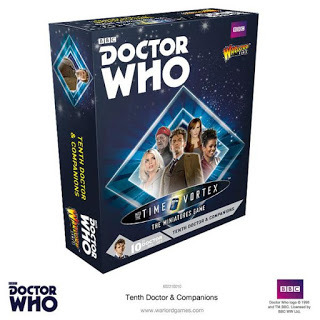
I've always had a soft spot for little metal miniatures. Ever since Fine Art Castings first started rolling them off their production line (in truth a casting machine in their garage!) in 1984, there have probably been more little metal figures of Doctor Who characters produced than most other items of merchandise (excluding, probably, trading cards if you count the cards individually!)
Now Warlord Games has picked up the license, and their initial release are two boxes, each containing five little figures. Each box costs £19.99 which makes them £4 each, which is about the same price as other 40mm figures these days, so overall not too bad a price.
The figures tie into something called 'Into The Time Vortex: The Miniatures Game' but I have no idea what this is, and there's no clues on the boxes of figures ...

So ... we have one box which is 'Tenth Doctor and Companions' - this contains, as you might expect, the tenth Doctor, plus Rose, Martha, Donna, and Wilf (a surprising addition to be honest ... but then who else might they have chosen? Maybe Sarah Jane Smith?)
The figures are 40mm so quite small, and come unpainted. Each also has a little plastic stand which you have to glue yourself to the base of each figure. It's a nice set!
 The second box contains 'Twelfth Doctor and Companions' and here we have Doctor 12 of course, and also Clara, Vastra, Jenny and Strax. Again, a good selection.
The second box contains 'Twelfth Doctor and Companions' and here we have Doctor 12 of course, and also Clara, Vastra, Jenny and Strax. Again, a good selection.If you like the little miniatures, then these are a good addition to the collection. The packaging is a card box containing a plastic inner containing 6 little 'trays' and in each is a figure, and in the sixth are the bases. There's also a card wrap around the plastic inner with character details and so on printed on it.
I'm looking forward to seeing what the actual game is too ...I'm guessing some sort of 'Dungeons and Dragons' type scenario, or it could be a 'Monopoly'-type board game ... we shall see!
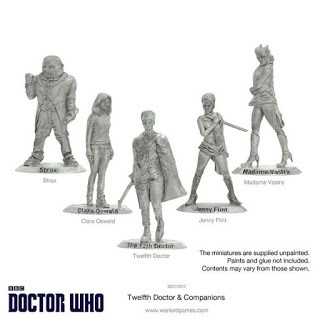
The Warlord Figures are available direct from the manufacturers: https://store.warlordgames.com/collec...
Published on September 21, 2016 03:13
September 12, 2016
Review: Too Late For Tears (1949) And Woman On The Run (1950)

These two
late-period film noirs became available in the UK from Arrow Films in June 2016
as a matching pair of dual-format Blu-Ray and DVD combos, essentially replicating
equivalent US releases from Flicker Alley the previous month. Both movies are
presented in top-notch new high-definition restorations courtesy of the UCLA
Film & Television Archive, and their release was made possible by the sterling
efforts of the Film Noir Foundation, an admirable organisation dedicated to the
preservation and appreciation of film noir.
Too
Late for Tears stars two noir icons, Lizabeth Scott and Dan Duryea. Scott’s
character, Jane Parker, is out driving in the Hollywood Hills one evening with
her husband Alan, played by Arthur Kennedy, when a suitcase full of illicit
cash lands in their laps – almost literally, as it is thrown into the back of
their moving car by a member of a criminal gang in a bizarre case of mistaken
identity. She then proceeds to stake her claim as one of the most mercenary
women ever to be depicted on screen, as she does everything in her power to take
possession of the money and keep it from being recovered by its intended
recipient, Duryea’s character, Danny Fuller. Alan is just the first of several
people who come to a sticky end when they try to oppose her …
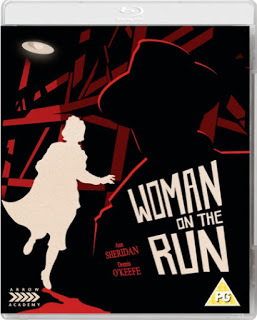
In
Woman on the Run, struggling artist Frank
Johnson, played by Ross Elliott, is the chance witness of a supposed gangland
murder, but makes himself scarce before the police can take him into protective
custody. His semi-estranged wife, portrayed by the movie’s star Ann Sheridan,
then plays a cat-and-mouse game with the police as they both try to track Frank
down before the murderer can get to him and eliminate him.
One
of the main things that these two movies have in common, and that makes their
pairing-up for release coincidentally rather apt, is their inclusion of strong
female lead characters, who are both equally determined and unrepentantly
single-minded in their own individual ways. Scott’s character in particular is
an archetypal femme fatale, and certainly not a woman anyone would want to
cross! Scott and Sheridan give excellent, career-highlight performances in
their respective roles, and the movies as a whole are both extremely enjoyable,
although Woman on the Run, with its
unusual fairground-set climax, probably just has the edge.
The
Film Noir Foundation deserves much kudos for its dogged and ultimately
successful campaign to get these movies restored and then commercially
released, and any noir aficionados unfamiliar with the organisation’s work
would be well advised to check out its website at www.filmnoirfoundation.org
and consider making a small donation to its ongoing cause, in return for access
to regular downloads of its superb quarterly magazine Noir City.
These
Arrow releases both come highly recommended; and each is rounded off with a
strong package of extras:
Too
Late for Tears
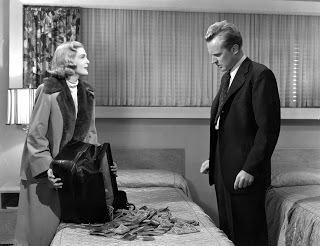
Optional English subtitles for the deaf and hard of hearing.
Audio commentary by writer, historian and film programmer Alan K Rode
Chance of a Lifetime: The Making of ‘Too Late for Tears’, a new behind-the-scenes examination of the film’s original production, produced by Steven Smith and the Film Noir Foundation and featuring noir experts Eddie Muller, Kim Morgan, and Julie Kirgo.
Tiger Hunt: Restoring ‘Too Late for Tears’, a chronicle of the multi-year mission to rescue this lost noir classic, produced by Steven Smith and the Film Noir Foundation.
Gallery featuring rare photographs, poster art and original lobby cards.
Reversible sleeve featuring original poster artwork on one side, and newly-commissioned artwork by Matt Griffin on the other.
Booklet featuring new writing by writer and noir expert Brian Light.
Woman
on the Run
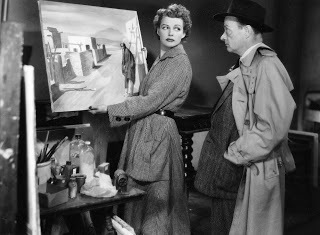
Optional English subtitles for the deaf and hard of hearing.
Audio commentary by author, historian and noir expert Eddie Muller.
Love is a Rollercoaster: ‘Woman on the Run’ Revisited, a new featurette on the making of the film, from script to noir classic, produced by Steven Smith and the Film Noir Foundation.
A Wild Ride: Restoring ‘Woman on the Run’, a stranger-than-fiction featurette on the film’s restoration, produced by Steven Smith and the Film Noir Foundation.
Noir City, a short documentary directed by Joe Talbot about the annual Noir City Film Festival, which the Film Noir Foundation hosts at San Francisco’s historic Castro Theatre.
Gallery featuring rare photographs, poster art and original lobby cards.
Reversible sleeve featuring original poster artwork on one side, and newly-commissioned artwork by Matt Griffin on the other.
Booklet featuring new writing by Eddie Muller.
Stephen
James Walker
Published on September 12, 2016 04:19
September 7, 2016
Review: Dead End Drive-In (1986)
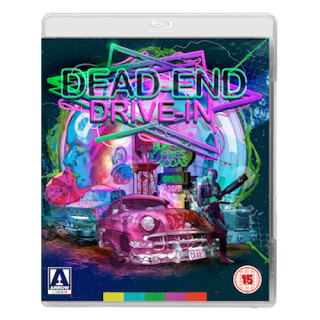
This is another Arrow Blu-Ray/DVD release and another film I'd never heard of before ... and probably with good reason. It seems to be Australian-made, with no known actors in, and is a sort of Mad-Max-esque low budget tale of low-lifes.
It takes an age to get going ... we are introduced to our unlikable cast of characters, and two of them, Crabs (Ned Manning) and Carmen (Natalie McCurry) decide to go to the Drive-In to make out. Except that the Drive-In has no Drive-Out, and after they identify themselves as Unemployed, the Police come and take the wheels from their car, thus trapping them inside the Drive-In along with all the other unemployed scum from the city. The fences and gates around the place are electrified - it's a sort of unofficial prison for these people, though they do get vouchers they can exchange for food and drink ... there's a whole community here!
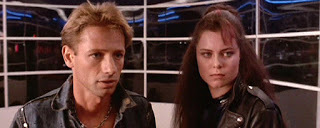
And so the action unfolds with car chases and explosions, '80s punked up outfits and cars and graffiti ... as Crabs tries to get some wheels for his car, but then runs out of petrol ... so he has to get some more petrol before he can try and make a break for freedom.
Somewhere in all this there's a good idea struggling to escape - the concept of luring undesirables to a place with a cheap offer for the unemployed, and then trapping them there. But the film is slow to get going, and then when it does get going, it's not sure where it wants to go. It's not clear how the Police get away with what they're doing ... does no-one realise that you never leave the Drive-In - there seems to be no 'word on the street' that people who go there never come back ...

It's nicely made though, and the action sequences are pretty good. It's not a film I'll rush to watch again though, and while it's set in a nominal future, there's nothing particularly 'horror' or 'science fiction' about it ... it could be happening now, or 20 years ago ...
SPECIAL EDITION CONTENTS
Brand new 2K restoration from original film materials
High Definition (1080p) Presentation
Optional English subtitles for the deaf and hard-of-hearing
Audio commentary by director Brian Trenchard-Smith
The Stuntmen, Trenchard Smith’s classic television documentary on Grant Page (Mad Max, Road Games) and other Australian stunt performers
Hospitals Don’t Burn Down, Trenchard-Smith’s 1978 public information film told in pure Ozploitation fashion
Behind the scenes gallery by graffiti artist Vladimir Cherepanoff
Theatrical trailer
Reversible sleeve featuring original and newly commissioned artwork by Chris Malbon
First pressing only: fully-illustrated collector’s booklet containing writing on the films by Cullen Gallagher and Neil Mitchell

Published on September 07, 2016 06:42
August 22, 2016
Review: The Official Doctor Who Cookbook
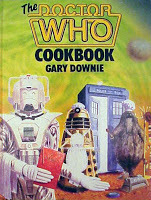 It's been some time since we had a Doctor Who cookbook produced under official license. The last time was way back in 1985 when Gary Downie, partner of the then-television producer of the show, John Nathan-Turner, and sometime choreographer, produced one for W H Allen, at a time when it seemed that anything with Doctor Who on the front could be published ... On that occasion the recipes were sourced from people who had appeared in or had some other connection with the show and was basically their favourite dishes, but with 'who-ified' names. No attempt was made to make the dishes look like actual monsters or aliens and so on ...
It's been some time since we had a Doctor Who cookbook produced under official license. The last time was way back in 1985 when Gary Downie, partner of the then-television producer of the show, John Nathan-Turner, and sometime choreographer, produced one for W H Allen, at a time when it seemed that anything with Doctor Who on the front could be published ... On that occasion the recipes were sourced from people who had appeared in or had some other connection with the show and was basically their favourite dishes, but with 'who-ified' names. No attempt was made to make the dishes look like actual monsters or aliens and so on ...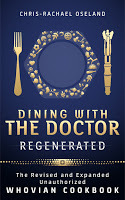 Then an unofficial book appeared a couple of years back in 2012, self-produced by Chris-Rachael Oseland and available on Amazon. What's interesting here is that in this new official cookbook, the author seems to have had some identical ideas as Oseland. So both books feature Bow Tie Pasta, Jammie Dodgers and, of course, fish fingers and custard, but then I guess that some things are too obvious. The main difference is that Oseland includes loads and loads of recipes inspired by just about every story of the new series. There's an updated and revised edition of this book in the works, which Oseland wants to publish in a better format than the original self-published one ...
Then an unofficial book appeared a couple of years back in 2012, self-produced by Chris-Rachael Oseland and available on Amazon. What's interesting here is that in this new official cookbook, the author seems to have had some identical ideas as Oseland. So both books feature Bow Tie Pasta, Jammie Dodgers and, of course, fish fingers and custard, but then I guess that some things are too obvious. The main difference is that Oseland includes loads and loads of recipes inspired by just about every story of the new series. There's an updated and revised edition of this book in the works, which Oseland wants to publish in a better format than the original self-published one ...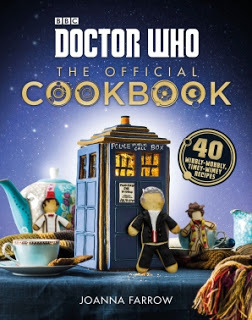
In this new BBC book, which contains just 40 recipes, one distinctly gets the idea that the recipes are way too hard for most kids to make, and the decoration relies on you being an expert and professional artist, sculptor and painter. Most of the recipes are shown in finished form as perfect cakes, pastries and dishes, but to get them looking like that would just not be possible for most mortal cooks. I'm reminded of the many internet sites which show the 'aspiration' against the 'reality', showing just how hard it is (here's an example ... http://www.hexjam.com/uk/food-drink/18-expectation-vs-reality-cooking-fails). There's an 'Exterminated Jelly Skeleton' which requires you to make perfect-looking bones from meringue ... which is the stickiest and hardest to shape substance known to man! The recipe says: 'Pipe an 8-9cm length of meringue onto the paper. Pipe an extra blob at each end to create a bone shape.' Hmmm ... can't see the result looking even remotely like the perfect bone shapes shown in the photograph ... as for the bread baked to look like an Ood head ...!
So I'm not quite sure who this book is aimed at. Even something which should be simple, like making little biscuit Doctors, relies on having a cutter in the right shape (or you have to trace a shape provided in the book onto paper and then somehow use it to cut each little man out ... But then you need a rock-steady hand, lots of different colours of icing, and a thin icing pipette to be able to decorate them ...
On the Cyberman head open sandwiches, there's a blob of hoisin sauce for the eyes, but in the picture, it is perfectly positioned and even has the little 'tear drop' present on the bottom corner ... not something that I suspect is even remotely possible to do in the real world!
The Snowman cake has perfectly jagged icing teeth ... again I feel that the actuality would be something looking more like the Snowman had been battered with a hammer and then partially melted in real life ... all the images show the results as being too perfect and finished. In fact to the extent that I wonder how much photoshop has been employed to make the images look perfect. The credit reads: photography and prop styling - Haarala Hamilton ... but what does 'prop styling' mean?
Overall it's a nice looking book, full of colour pictures, and the ideas are good and cover all elements of food from snacks to savoury to desserts, sweets and cakes. £14.99 is also not too expensive for the book, making it maybe an impulse Christmas buy for someone who loves cooking? But to be honest I'd hate to have to try and actually make some of the recipes as I just know that my results would bear little resemblance to the perfect images in the book.
DOCTOR WHO: THE OFFICIAL COOKBOOK is published by BBC Books. £14.99 hardback
Published on August 22, 2016 04:56
August 2, 2016
The Doctor Who Experience - July 2016
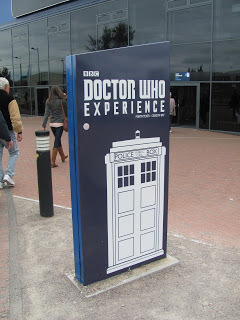
Alongside our amazing visit to the TARDIS set, we also enjoyed an afternoon at the Doctor Who Experience, a semi-permanent Doctor Who exhibition and museum which is sited pretty much next door to the BBC's Roath Lock Studios ...
The Experience is part-interactive and part-walk-around-museum, and it's built on previous exhibitions such that it is now very impressive, and very well done indeed! I remember the early days of Blackpool and Longleat where the best you got was a video of Tom Baker wishing you well! But these days it's all dry ice and 3D video as you are walked through and immersed in your very own adventure.
I won't say too much lest it spoil it for future visitors, but it's all about an invasion by something called the Crinis, and the 12th Doctor is there on the screen, talking to your guide, and helping you through the various challenges you face. Are there Daleks? Of course there are! Are there Weeping Angels? You betcha! But you come through (mostly) unscathed and enter the main exhibition through a nice pair of junkyard doors with the name I M Foreman written on ...
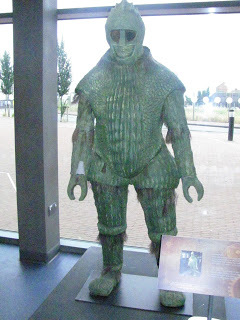
An Ice Warrior in the entrance foyer
There is so much in the exhibition, that the best way to explain it is just to show all the pictures I took! There are Daleks and Cybermen, Sontarans and Zygons, Doctor and Companion costumes galore, and four (count them!) FOUR TARDIS control rooms: We have the one from the Mark Gatiss Docudrama An Adventure in Space and Time from 2013, which replicates the William Hartnell console (which was used up until 'The Ambassadors of Death'); then there's the Davison model (used from 'The Five Doctors' until the end of the Classic series in 1989); and finally the Eccleston/Tennant 'coral' model. Opened since we visited (we missed it by a day!) is yet another console, this time the T Baker/Davison model (used from 'The Invisible Enemy' until 'Enlightenment'). **I might have some of these stories wrong ... info is from http://www.themindrobber.co.uk/tardis-console-history-details.html :)
Overall everything is really nicely displayed, with one or two larger props present as well as the costumes. The Experience focuses on the current series, so there's lots of Clara's outfits, and items from many of the most recent episodes, like the Mire, Me's outfits, Costumes and props from the 'Under the Lake' and 'Sleep No More' episodes, plus the hooded creature (the Veil) and teleport booth from 'Heaven Sent' ... overall an excellent set of artefacts which covers probably as much of the series as it can.
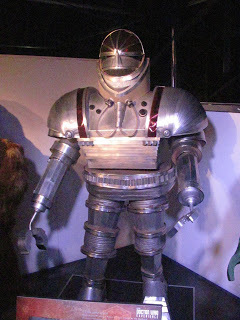
The K1 Robot
It was very nice to see some earlier costumes there, which have been repaired, reconstructed and refurbished by Mike Tucker and his team at the The Model Unit ... especially the magnificent K1 Robot from 'Robot' and a Zygon from 'Terror of the Zygons' ... not to mention a Tetrap from 'Time and the Rani' and Omega from 'Arc of Infinity' ... There's not that much that exists from earlier adventures (there's a lovely Yeti from 'The Web of Fear') and what does exist tends to be in private hands ... indeed, several of the items on display are noted as coming from private collections, so it's to be applauded that those who own these pieces have allowed them to be displayed and appreciated by everyone!
On our visit to the Experience, we were in very good company. Frazer Hines, who played Jamie McCrimmon alongside the second Doctor, was with us, and also Paul McGann, the eighth Doctor, popped down to Cardiff to join us on our day out. So we battled the Crinis with them, and then wandered the Exhibition, cooing at all the marvellous items on display. As I said to Paul and Frazer though, what was needed was more Jamie and more eighth Doctor items ... unfortunately there just aren't many of them around to display!

Paul McGann and Frazer Hines
Because we had these two gentlemen with us, the staff were very kind and allowed us to take some pics on the sets themselves - these are roped off to protect the fragile consoles and, indeed, Bessie the yellow roadster, and visitors are not permitted to get too close to them. We were very careful however, and under the watchful eyes of the Curator and staff the whole time ... otherwise who knows where Paul might have navigated the console to! So if you go to the Experience yourself (and I heartily recommend you do!) then please don't try and pass the barriers yourself, lest you feel the long arm of the security staff on your collar!
We had a simply marvellous time, and even managed to buy some interesting things in the shop at the end (I love a little shop!).
So thanks to the Curator and staff at the Experience for a truly out of this world experience ... and to my fellow travellers: Sam Stone, Amy Windham, Howard Hayes, Ken Deep, James Naughton, Frazer Hines and Paul McGann ... And we hope readers head over to Cardiff to have your very own Doctor Who Experience!
And now ... the pictures ... And for reasons best known to itself, Blogger has put them all in reverse order! And they are all of course (c) me so no pinching!
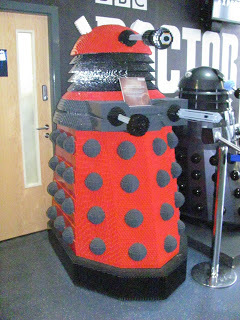
A Lego Dalek!

A happy group of time travellers ... Don't touch that switch Frazer!
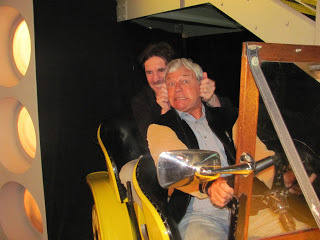
Paul and Frazer clown about in Bessie
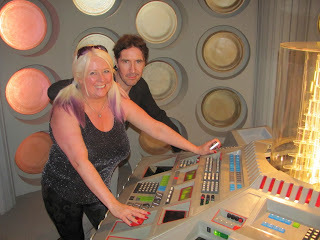
Sam and Paul ... Travellers in Time!
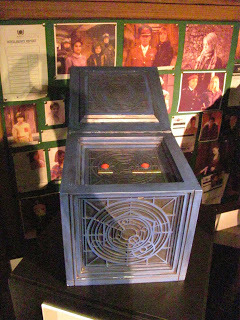
But which box?
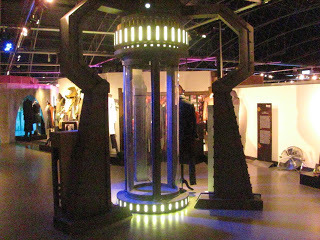
A Doctor will teleport in momentarily ...
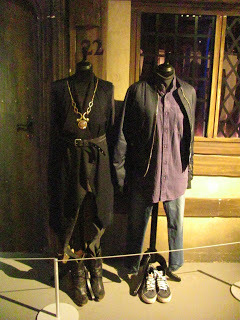
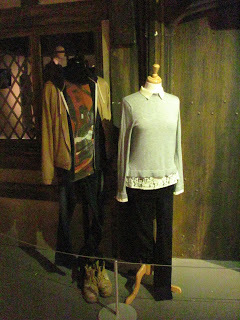
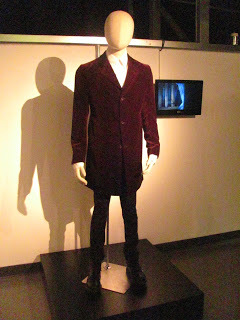
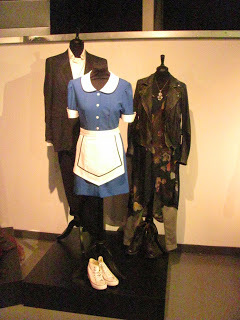
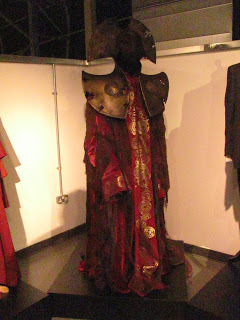
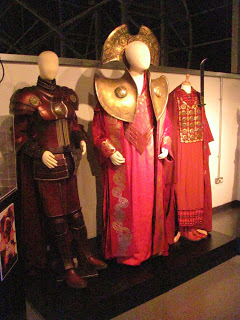
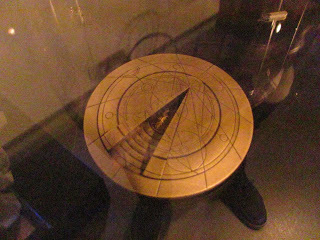
The Doctor's Confession Dial
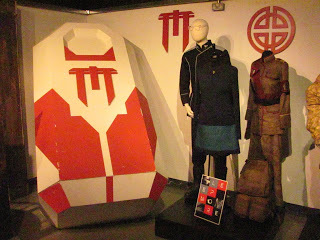
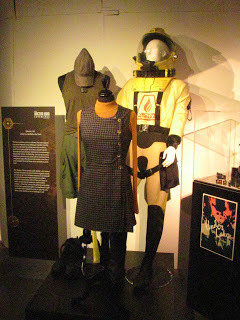
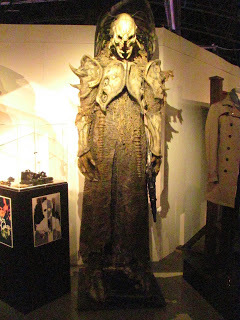
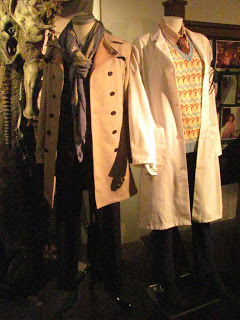
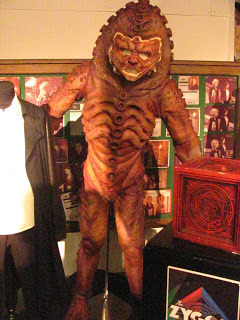
Something very strange about the face of this
new series Zygon.
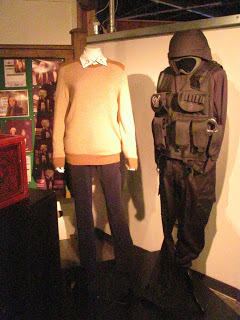
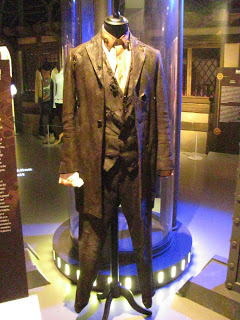
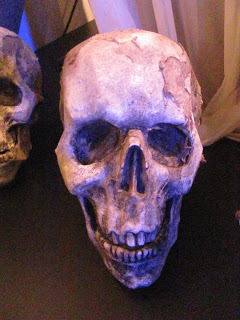
A Doctor skull
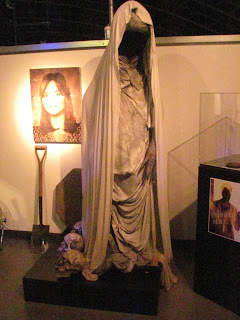
The Veil ,,, coming for you
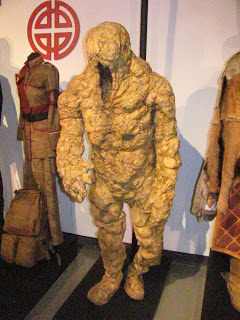
Eye-sand monster
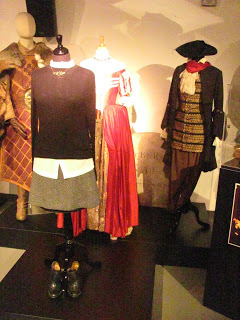
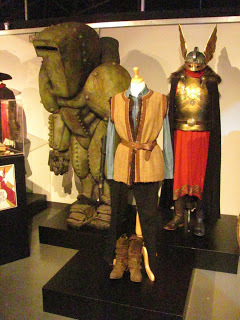
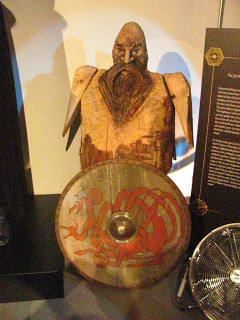

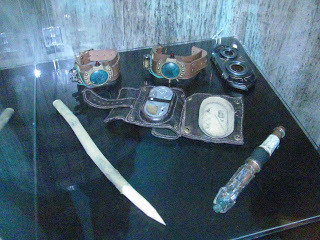
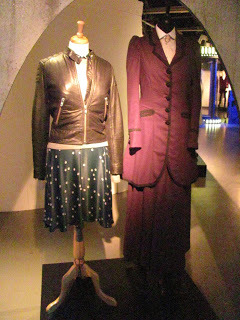
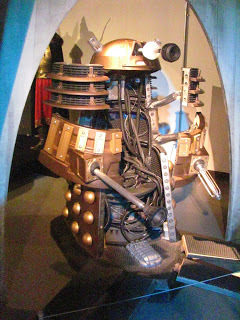
The Dalek in which Clara was installed
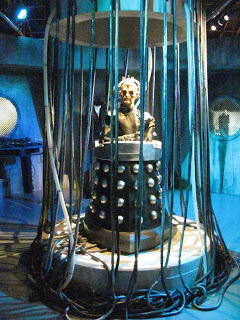
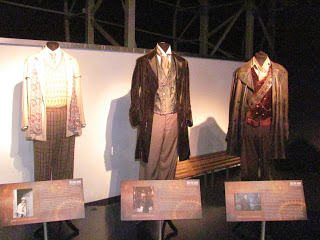
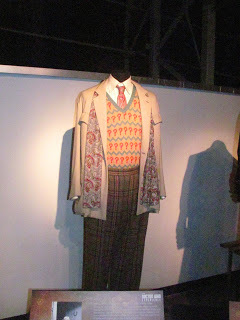

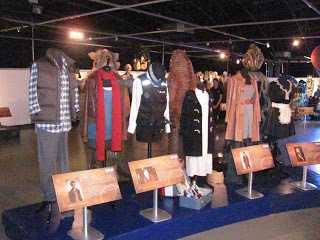

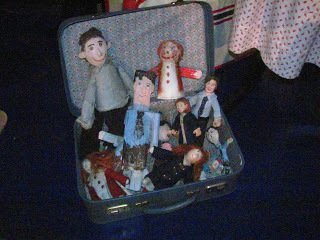
Amy Pond's collection of dolls
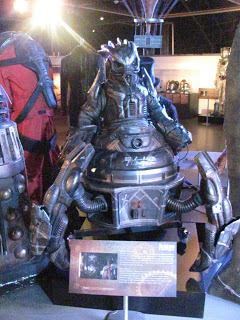
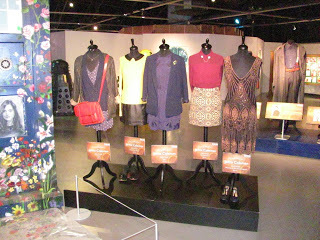
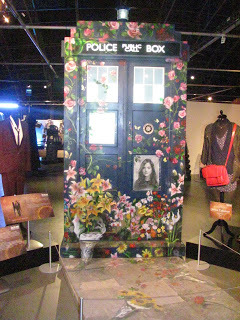
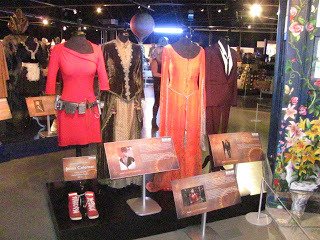
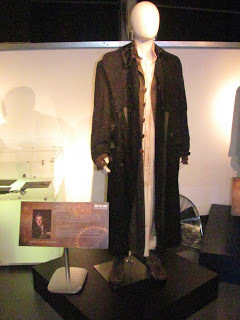
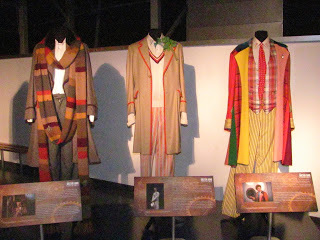
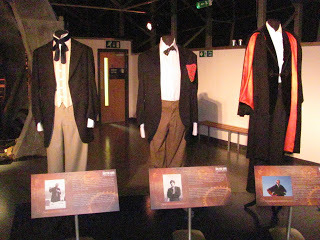
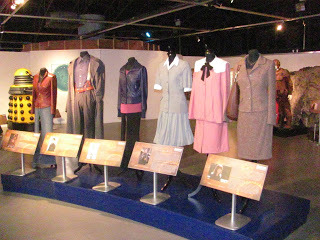
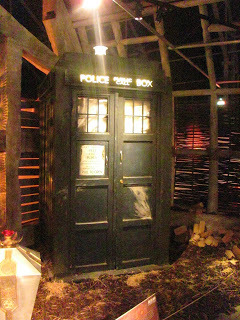
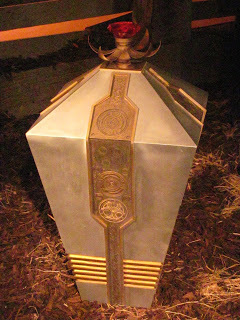
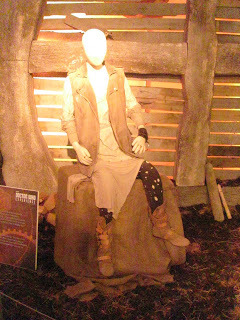
This is my moment ...
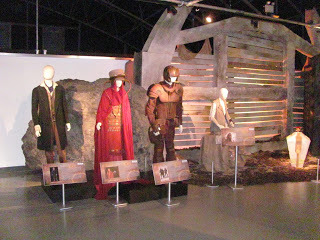

Tellytubby Dalek

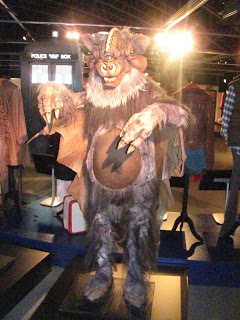
Tetrap
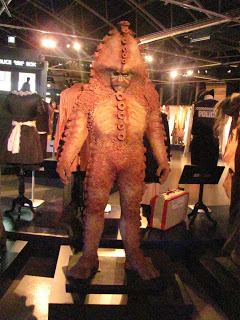
Superb recreation of an original Zygon
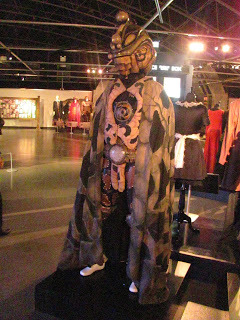
Omega
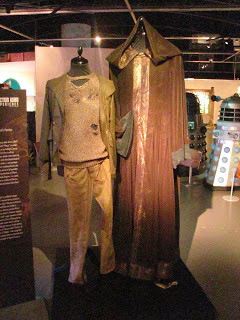
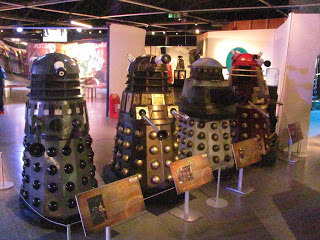
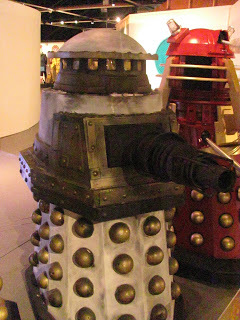
The Special Weapons Dalek
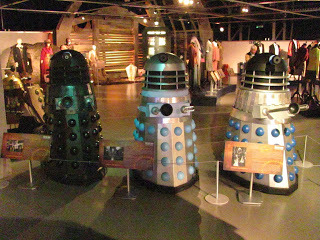
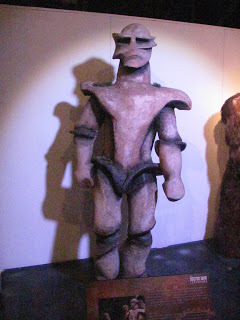
Melkur
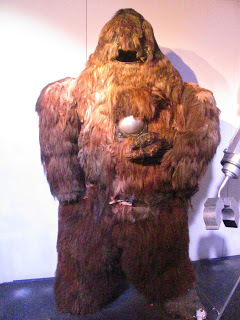
Original sixties Yeti, complete with ball
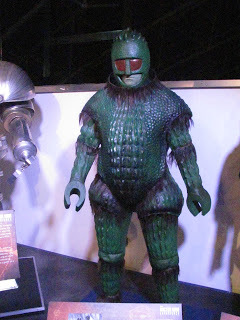
Original Ice Warrior
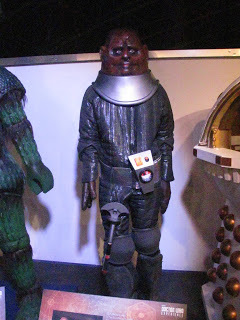
'The Two Doctors' style Sontaran
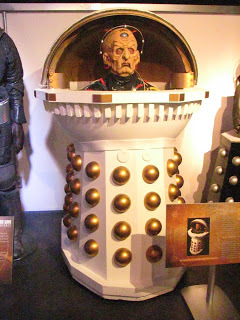
Davros as the Emperor Dalek

Davros!
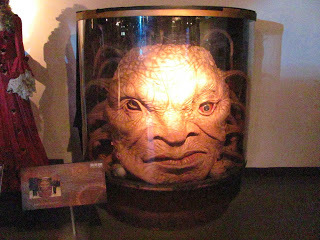
The Face of Boe


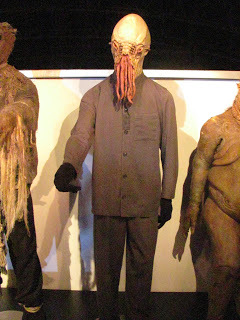




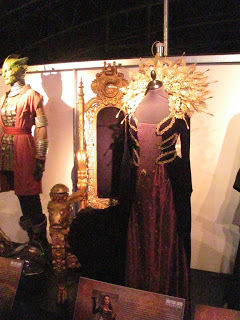
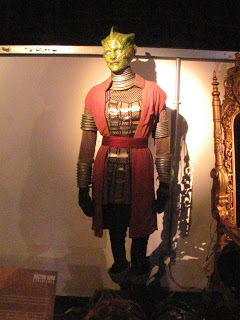
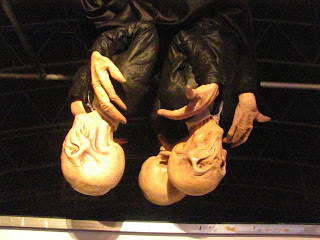
Just hanging around
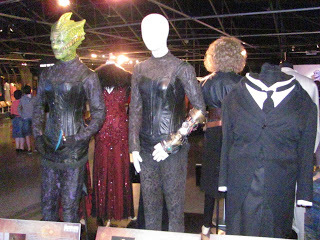
Outfits for the Paternoster Gang
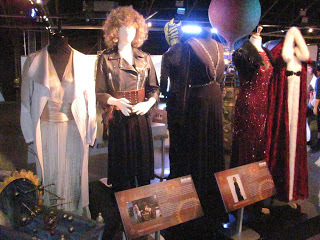

The Doctor's crib
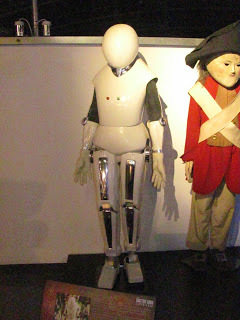

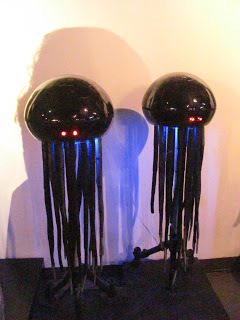

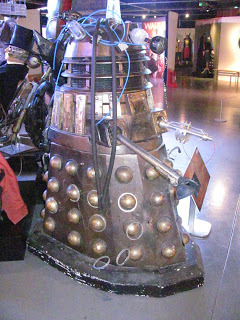
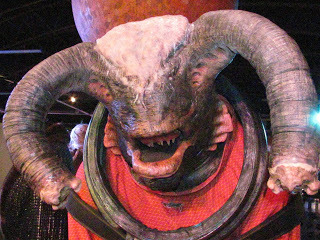
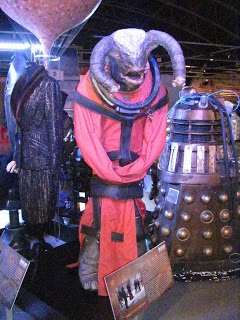

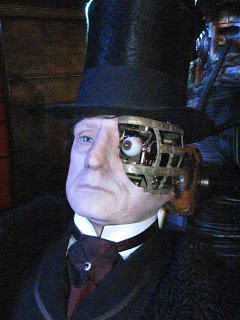
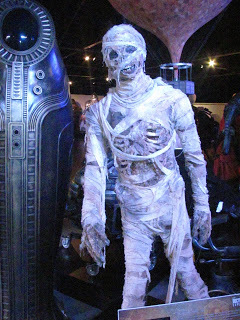
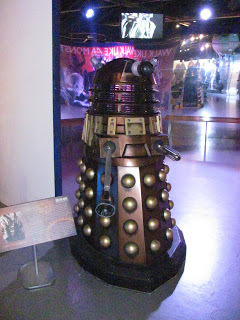

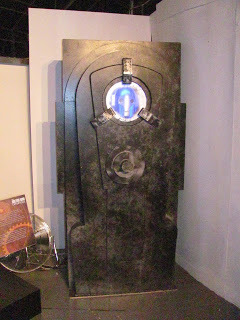
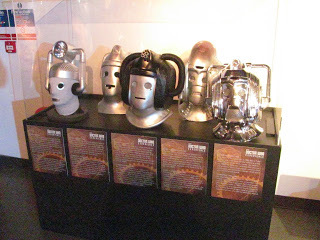




I didn't remember this thing from the show but
apparently it was there!



Beautiful original console

Three TARDISes together ,,,

Five Doctors console

Coral console


A display of the Radiophonic Workshop's work on the show.


Three Daleks







A Menoptra from 'An Adventure in Space and Time'

'Five Doctors' console

Bessie

K9!




Entering the exhibition

Don't Blink!




A Weeping Angel in the foyer


A Smiler booth in the Cafe area

Artwork in the cafe area


Published on August 02, 2016 01:25
July 31, 2016
Transdimensional TARDIS Visit at Cardiff

Sometimes the world tilts in just the right way, and you find yourself enjoying something which is exclusive and amazing and which just ticks one of those bucket items on the long list of aspirational things to do ... Such it was on a recent trip to Cardiff, where we had the opportunity to visit the actual working TARDIS set from Doctor Who, the one that the 12th Doctor, Peter Capaldi, actually uses for his travels in Space and Time!
This was due to Ed Russell, Brand Manager for Doctor Who, who generously offered to show us around the set while the main Doctor Who team was off filming in Spain. He arranged for the lights to be put on especially for us, and we had no restrictions or limitations placed on us (except for a 'no video' rule, which of course we complied with). I'm told that there is a TARDIS tour that you can pay for as an 'add on' to a visit to the Doctor Who Experience, but this is only when they are not recording the show, and on these visits, the console and upper level is roped off ...

The entrance to the TARDIS ...
My first impression of the set was that it was massive. It rests in its own studio at Roath Lock, and takes up most of it! You enter through the actual external TARDIS doors, which is a lovely touch, and inside, it's like a bubble of Time Lord Technology.
I actually love this control room. It feels functional and right in a way that the Eccleston/Tennant/Smith ones didn't ... and I was very impressed that the console is indeed fully functional, with switches and levers and buttons that mostly make lights light up and things move. There's a gorgeous illuminated cog arrangement on one panel which is a work of art, and another has the interface to the TARDIS' telepathic circuits: a Zygon-like latex/silicon panel of bumps and grooves into which you can plunge your fingers.
On the upper level there are bookcases full of books, tables piled with magazines and other things, blackboards covered with arcane scribblings ... skulls, ornaments ... all manner of exotic ephemera. It's lovely! You can walk around the whole room, with staircases down to the main console area, and there are also blocked off exits to the rest of the TARDIS as well ... We were told that sections of the upper area can be removed to allow cameras in, but it works brilliantly as an enclosed space as well.

Under the main area there's the lower floor, which again has tables covered with bits of junk and equipment, there's a hatstand, chairs ... and the under-console area, which again is fully practical in that each section lifts up allowing access to the tubes and pipes and whatever else they want to put down there. I was so impressed at the thought which has gone into making the whole set as practical and tactile as possible, so that pretty much any future requirement can be incorporated depending on what the scripts demand. Very clever. This also helps to ground the TARDIS as a real object, a solid and practical space where the Doctor and companions can live and travel and which feels like home.

Under the console ... just doing a little rewiring ...
This is of course the whole point and indeed ethos of the TARDIS from the early years of the show, and it's great to see that reflected again here. At no point does this feel like a set! You are actually in the TARDIS, and it's all lit up! Magnificent!
Outside the set, there are the usual boxes of unidentified stuff, and even a Dalek sits forlornly there too ... whether waiting for use in future episodes, or the sole remnant of a Dalek attack on the TARDIS we don't know ... it's cool to see it there though!
There is also another set under construction in the same studio, but this is for the next season and thus is top secret ... Apparently it's supposed to tie in and match with something on location, but as we don't know what that is either, it's all a bit bewildering ... I'm sure it will come clear when the episodes are transmitted ...

We landed safely!
We ended our visit feeling uplifted and privileged that we got to visit the Doctor's TARDIS ... we may not have travelled in time and space, but in our minds we battled Daleks and Cybermen and Zygons as the Doctor rushed around the control room in a haze of blue velvet and scots accent ... Magnificent!
Here's a selection of pics from the visit ...

Sam checks out the books

A lone Dalek outside the TARDIS set

We enter the TARDIS for the first time ...

The top part of the console.

Blackboards and arcane scribblings

The amazing central console

Another view

Trying to get us home ...

External view of one of the exits from the
Console Room ... this would lead to the
rest of the ship ...

Beautiful section of the ship

Sam checks in with the Doctor ...

We all need some help!

Sam under the console!

The amazing cog and gear panel on the console

Sam is in da Ship!

Making sure the Doctor got his sums right ...

Another view of the console room. The external door is in the
middle.

Sam links into the telepathic circuits ...
Published on July 31, 2016 04:55
July 8, 2016
The Reprint Conundrum: Target Doctor Who Novelisations
I was tagged in a Facebook post today (On the Doctor Who Collectors Group) about reprints of the Target Doctor Who novelisations as some collectors were getting very confused about the reprints, how you could identify them and so on. And as it's a far more complex subject than you might imagine, and as Facebook is very transient, I thought it was worth putting some thoughts and explanations on the Blog so that they can be referred to going forward, maintained and updated with new information, and generally remain accessible to anyone who wants to know.
Throughout this piece I will refer to the Toybox site. This is an online resource for Doctor Who collectors which attempts to catalogue every item of Doctor Who merchandise ever released ... and of course this includes the Target Books. But also, for the Targets, we also tried to document every reprint we knew about or could find. It's not complete, but it's a pretty good starter for ten and also has cover images showing variances and so on ... so it's a good place to go. www.doctorwhotoybox.co.uk
Okay. First things first. These are books, and books have an identifying number called an ISBN. This stands for International Standard Book Number, and is (or should be) a way to uniquely identify a given book. The rules say that every book should have a unique ISBN. If you change the book's format (ie it's physical size) or it's Cover Image, or it's content (significantly rather than minor corrections), or it's language, or it's publisher, or it's title then you should give it a new ISBN. The 'rules' can be found here if you're interested ... https://www.isbn-international.org/content/isbn-assignment.
In practice, however, this doesn't happen, and you get all manner of things going on. But as a general rule of thumb, the ISBN for the Target books follows this pattern. So the first editions will each have their own ISBN. and that ISBN remains constant until they change the cover art ... most of the time.
If we look at the Book Covers now, and obviously each book has it's own cover. The first 12 books have the Pertwee Doctor Who logo. Which looks like this:

They they changed it to the T Baker logo like this ('The Giant Robot' was the first title to use this logo but that has Tom Baker's face over the 'O' so is not really representative):

:
Before moving on to the Davison logo:

Then the McCoy Logo:

And finally, to a totally different cover design for the last couple of books:

First editions (and we're talking first edition paperbacks here. Most of the Target books had hardback editions as well, some of which were published prior to the paperback editions, some of which were published at the same time as the paperback editions, but NONE of the hardbacks were badged as 'Target') will have specific colours for the logos and text, and these changed for reprint editions. So on the Toybox site, you will see that we try to highlight what is different or specific about which edition of the book. Some reprints changed the logo style as well, and also the artwork changed for a reprint ... but not always.
But be careful when checking cover colours and spine/back cover colours as they can fade and change to different colours with extended exposure to sunlight.
So usually you can initially spot what might be a first edition from the cover, the logo, and the colourings ... but there can be some other changes too ... You see that first edition cover of 'The Daleks' above? Well the tagline under the Author Name 'Based on the popular BBC television series' ... that line is missing off some of the reprints.

There's also part of the ISBN number printed on the first edition spine of the first three titles only, and this is missing off some of the reprints ... so you have to be observant and diligent to be able to spot a first edition.
The other good identifier on the books is the cover price. The books started at 25p each, but then rose in price, pretty much each year. So the price will give an indication as to which year the book originated from. And bearing in mind the confusion over the insides (see later) this is very helpful indeed.
Moving to the insides of the book, and the first thing to note is that these books were all produced back in the days when the covers and the insides were printed separately, and then brought together when the books were bound. What this means is that sometimes the publisher found themselves with stacks of covers, and no books to put in them ... or sometimes it was the other way round, they had lots of what are called 'book blocks' and no covers to wrap around them.
So what they would do, was to reprint either the covers or the insides so they could bind the books and get them out to shops. BUT when they did this, they sometimes made changes to the insides or the covers ... so you can have a first edition cover, with a second edition book block inside it ... or a first edition book block with a reprint edition cover around it.
This makes it VERY hard to try and definitively pin down what edition is what ... there are so many changes!
Another point to note is that when covers were reprinted, they sometimes didn't go back to the original plates and artwork, and instead used a previous cover to reprint from. This means that some subsequent reprint covers are 'zoomed in' and lack detail. Also the colours can be harsher ... all these things are because they just took an earlier cover and used that as the basis for the new reprint.
Look at page 4 of a given book, and you will find the publishing information. This is supposed to tell you which edition it is, and sometimes publishers will print in it 'Second Edition' or 'Reprinted 1996, 1997 (twice), 1999' or whatever to show which this copy is. Another way this is done is by printing a sequence of numbers like this '2 4 6 8 9 7 5 3'. That sequence would indicate a second edition as the '2' is the lowest number there ... Others might have '3 4 5 6 7 8 9 10 11 12' which would indicate a third edition as '3' is the lowest number there.
Here's an example of a First Edition Target:

You can see that it DOESN'T SAY it's a first edition. Some books will however note this.
Here's the same page from a reprint edition:

You can see the FIRST PUBLISHED information, and that it also says SECOND IMPRESSION and REPRINTED IN ... So this is possibly a second edition, or possibly a third edition (the information can be interpreted to mean that the Second Impression was then reprinted again ... making this a third impression).
However, sometimes they didn't update the information on this page when they reprinted, meaning that while the cover might have been different, with a different price, the insides remained the same.
Here's another example of a reprint interior:

Here you can see the four reprints are noted.
If you look on the Toybox site, you'll see that some of the books have loads and loads of reprints, while others have very few indeed, and some have none! This is simply because as the range continued, the publishers learned how many to print, and if they got their sums right, then no reprint was ever needed. Especially too as they got to the end of the range, when they knew that they couldn't afford to end up with loads in stock ... Again, the print runs, where known, are noted in the Toybox listings.
I think those are the main points ... to summarise:
Check the cover:
Is the logo correct
Is the colour correct
Is the cover image correct
Is the cover price correct
Is the ISBN correct
Check inside:
Does it indicate any reprint editions?
Is the ISBN the same as the cover?
If all these are confirmed, then congratulations, you probably have a first edition!
Throughout this piece I will refer to the Toybox site. This is an online resource for Doctor Who collectors which attempts to catalogue every item of Doctor Who merchandise ever released ... and of course this includes the Target Books. But also, for the Targets, we also tried to document every reprint we knew about or could find. It's not complete, but it's a pretty good starter for ten and also has cover images showing variances and so on ... so it's a good place to go. www.doctorwhotoybox.co.uk
Okay. First things first. These are books, and books have an identifying number called an ISBN. This stands for International Standard Book Number, and is (or should be) a way to uniquely identify a given book. The rules say that every book should have a unique ISBN. If you change the book's format (ie it's physical size) or it's Cover Image, or it's content (significantly rather than minor corrections), or it's language, or it's publisher, or it's title then you should give it a new ISBN. The 'rules' can be found here if you're interested ... https://www.isbn-international.org/content/isbn-assignment.
In practice, however, this doesn't happen, and you get all manner of things going on. But as a general rule of thumb, the ISBN for the Target books follows this pattern. So the first editions will each have their own ISBN. and that ISBN remains constant until they change the cover art ... most of the time.
If we look at the Book Covers now, and obviously each book has it's own cover. The first 12 books have the Pertwee Doctor Who logo. Which looks like this:

They they changed it to the T Baker logo like this ('The Giant Robot' was the first title to use this logo but that has Tom Baker's face over the 'O' so is not really representative):

:
Before moving on to the Davison logo:

Then the McCoy Logo:

And finally, to a totally different cover design for the last couple of books:

First editions (and we're talking first edition paperbacks here. Most of the Target books had hardback editions as well, some of which were published prior to the paperback editions, some of which were published at the same time as the paperback editions, but NONE of the hardbacks were badged as 'Target') will have specific colours for the logos and text, and these changed for reprint editions. So on the Toybox site, you will see that we try to highlight what is different or specific about which edition of the book. Some reprints changed the logo style as well, and also the artwork changed for a reprint ... but not always.
But be careful when checking cover colours and spine/back cover colours as they can fade and change to different colours with extended exposure to sunlight.
So usually you can initially spot what might be a first edition from the cover, the logo, and the colourings ... but there can be some other changes too ... You see that first edition cover of 'The Daleks' above? Well the tagline under the Author Name 'Based on the popular BBC television series' ... that line is missing off some of the reprints.

There's also part of the ISBN number printed on the first edition spine of the first three titles only, and this is missing off some of the reprints ... so you have to be observant and diligent to be able to spot a first edition.
The other good identifier on the books is the cover price. The books started at 25p each, but then rose in price, pretty much each year. So the price will give an indication as to which year the book originated from. And bearing in mind the confusion over the insides (see later) this is very helpful indeed.
Moving to the insides of the book, and the first thing to note is that these books were all produced back in the days when the covers and the insides were printed separately, and then brought together when the books were bound. What this means is that sometimes the publisher found themselves with stacks of covers, and no books to put in them ... or sometimes it was the other way round, they had lots of what are called 'book blocks' and no covers to wrap around them.
So what they would do, was to reprint either the covers or the insides so they could bind the books and get them out to shops. BUT when they did this, they sometimes made changes to the insides or the covers ... so you can have a first edition cover, with a second edition book block inside it ... or a first edition book block with a reprint edition cover around it.
This makes it VERY hard to try and definitively pin down what edition is what ... there are so many changes!
Another point to note is that when covers were reprinted, they sometimes didn't go back to the original plates and artwork, and instead used a previous cover to reprint from. This means that some subsequent reprint covers are 'zoomed in' and lack detail. Also the colours can be harsher ... all these things are because they just took an earlier cover and used that as the basis for the new reprint.
Look at page 4 of a given book, and you will find the publishing information. This is supposed to tell you which edition it is, and sometimes publishers will print in it 'Second Edition' or 'Reprinted 1996, 1997 (twice), 1999' or whatever to show which this copy is. Another way this is done is by printing a sequence of numbers like this '2 4 6 8 9 7 5 3'. That sequence would indicate a second edition as the '2' is the lowest number there ... Others might have '3 4 5 6 7 8 9 10 11 12' which would indicate a third edition as '3' is the lowest number there.
Here's an example of a First Edition Target:

You can see that it DOESN'T SAY it's a first edition. Some books will however note this.
Here's the same page from a reprint edition:

You can see the FIRST PUBLISHED information, and that it also says SECOND IMPRESSION and REPRINTED IN ... So this is possibly a second edition, or possibly a third edition (the information can be interpreted to mean that the Second Impression was then reprinted again ... making this a third impression).
However, sometimes they didn't update the information on this page when they reprinted, meaning that while the cover might have been different, with a different price, the insides remained the same.
Here's another example of a reprint interior:

Here you can see the four reprints are noted.
If you look on the Toybox site, you'll see that some of the books have loads and loads of reprints, while others have very few indeed, and some have none! This is simply because as the range continued, the publishers learned how many to print, and if they got their sums right, then no reprint was ever needed. Especially too as they got to the end of the range, when they knew that they couldn't afford to end up with loads in stock ... Again, the print runs, where known, are noted in the Toybox listings.
I think those are the main points ... to summarise:
Check the cover:
Is the logo correct
Is the colour correct
Is the cover image correct
Is the cover price correct
Is the ISBN correct
Check inside:
Does it indicate any reprint editions?
Is the ISBN the same as the cover?
If all these are confirmed, then congratulations, you probably have a first edition!
Published on July 08, 2016 01:48



